Research Report: Consumer Attitude Gap Towards Sustainable Fashion
VerifiedAdded on 2023/06/06
|7
|1830
|444
Report
AI Summary
This report investigates the consumer attitude gap towards sustainable fashion by analyzing survey responses and integrating existing research. The study reveals that while many consumers express concern for the environment and a positive view of sustainable products, their purchasing decisions are often influenced by factors like price, style, and limited options. The research highlights that younger, low-income individuals find it challenging to afford sustainable fashion, and a lack of trust in sustainability labels impacts consumer perception. The report also touches upon the influence of social media, the impact of the COVID-19 pandemic on shopping habits, and the limited influence of celebrities on purchasing sustainable brands, concluding that mere awareness of sustainability is insufficient to drive the demand for sustainable fashion without addressing cost and availability.
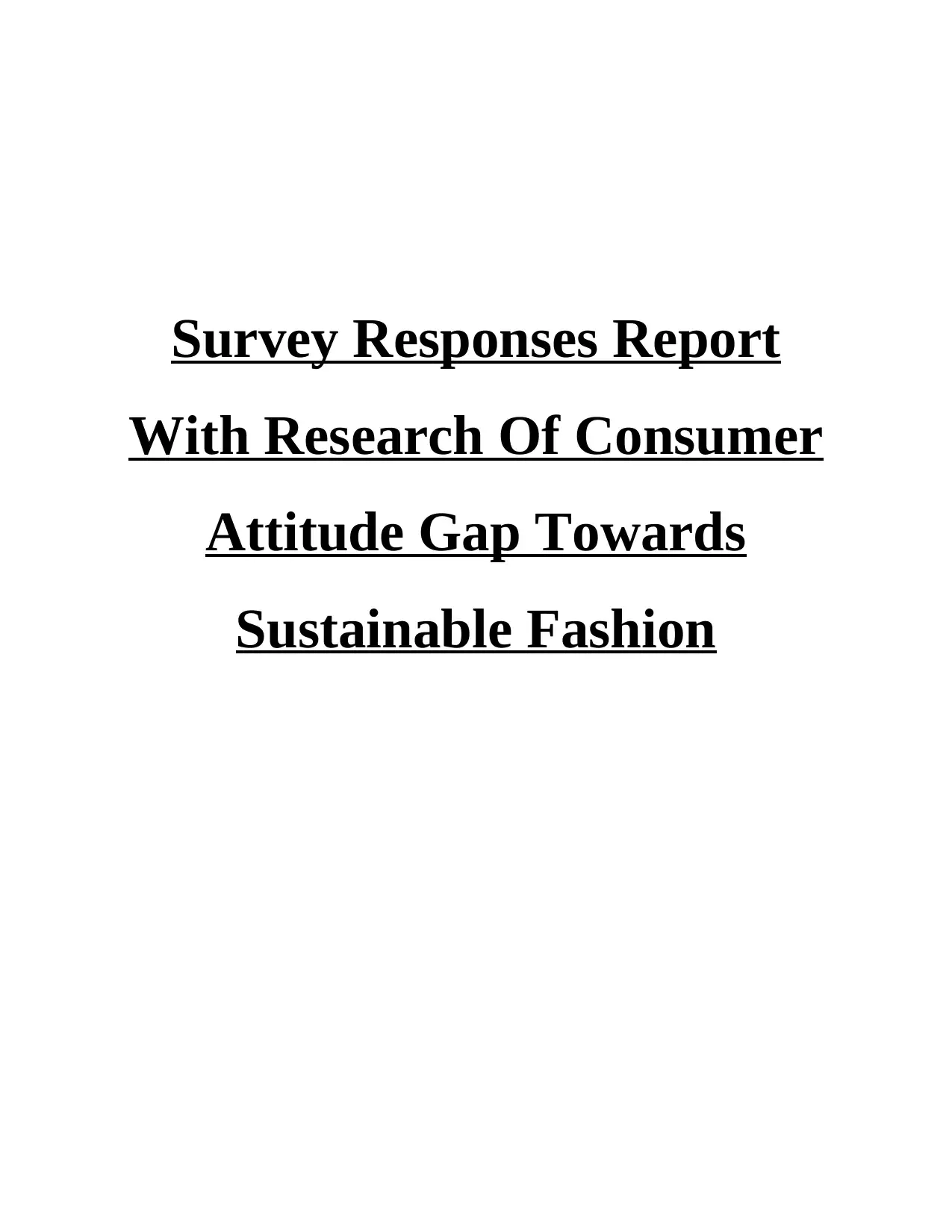
Survey Responses Report
With Research Of Consumer
Attitude Gap Towards
Sustainable Fashion
With Research Of Consumer
Attitude Gap Towards
Sustainable Fashion
Paraphrase This Document
Need a fresh take? Get an instant paraphrase of this document with our AI Paraphraser

Table of Contents
Discussion........................................................................................................................................3
REFERENCES................................................................................................................................1
Discussion........................................................................................................................................3
REFERENCES................................................................................................................................1
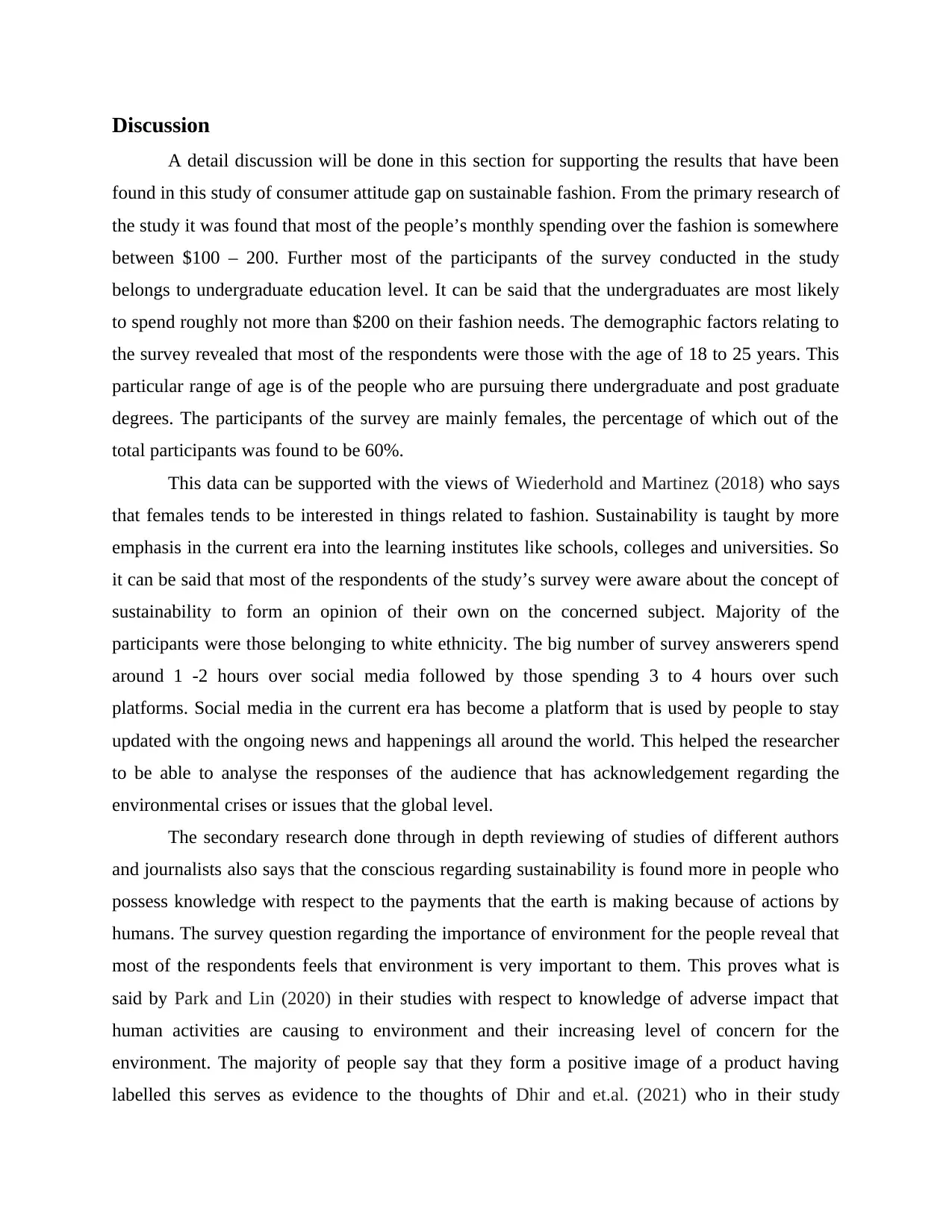
Discussion
A detail discussion will be done in this section for supporting the results that have been
found in this study of consumer attitude gap on sustainable fashion. From the primary research of
the study it was found that most of the people’s monthly spending over the fashion is somewhere
between $100 – 200. Further most of the participants of the survey conducted in the study
belongs to undergraduate education level. It can be said that the undergraduates are most likely
to spend roughly not more than $200 on their fashion needs. The demographic factors relating to
the survey revealed that most of the respondents were those with the age of 18 to 25 years. This
particular range of age is of the people who are pursuing there undergraduate and post graduate
degrees. The participants of the survey are mainly females, the percentage of which out of the
total participants was found to be 60%.
This data can be supported with the views of Wiederhold and Martinez (2018) who says
that females tends to be interested in things related to fashion. Sustainability is taught by more
emphasis in the current era into the learning institutes like schools, colleges and universities. So
it can be said that most of the respondents of the study’s survey were aware about the concept of
sustainability to form an opinion of their own on the concerned subject. Majority of the
participants were those belonging to white ethnicity. The big number of survey answerers spend
around 1 -2 hours over social media followed by those spending 3 to 4 hours over such
platforms. Social media in the current era has become a platform that is used by people to stay
updated with the ongoing news and happenings all around the world. This helped the researcher
to be able to analyse the responses of the audience that has acknowledgement regarding the
environmental crises or issues that the global level.
The secondary research done through in depth reviewing of studies of different authors
and journalists also says that the conscious regarding sustainability is found more in people who
possess knowledge with respect to the payments that the earth is making because of actions by
humans. The survey question regarding the importance of environment for the people reveal that
most of the respondents feels that environment is very important to them. This proves what is
said by Park and Lin (2020) in their studies with respect to knowledge of adverse impact that
human activities are causing to environment and their increasing level of concern for the
environment. The majority of people say that they form a positive image of a product having
labelled this serves as evidence to the thoughts of Dhir and et.al. (2021) who in their study
A detail discussion will be done in this section for supporting the results that have been
found in this study of consumer attitude gap on sustainable fashion. From the primary research of
the study it was found that most of the people’s monthly spending over the fashion is somewhere
between $100 – 200. Further most of the participants of the survey conducted in the study
belongs to undergraduate education level. It can be said that the undergraduates are most likely
to spend roughly not more than $200 on their fashion needs. The demographic factors relating to
the survey revealed that most of the respondents were those with the age of 18 to 25 years. This
particular range of age is of the people who are pursuing there undergraduate and post graduate
degrees. The participants of the survey are mainly females, the percentage of which out of the
total participants was found to be 60%.
This data can be supported with the views of Wiederhold and Martinez (2018) who says
that females tends to be interested in things related to fashion. Sustainability is taught by more
emphasis in the current era into the learning institutes like schools, colleges and universities. So
it can be said that most of the respondents of the study’s survey were aware about the concept of
sustainability to form an opinion of their own on the concerned subject. Majority of the
participants were those belonging to white ethnicity. The big number of survey answerers spend
around 1 -2 hours over social media followed by those spending 3 to 4 hours over such
platforms. Social media in the current era has become a platform that is used by people to stay
updated with the ongoing news and happenings all around the world. This helped the researcher
to be able to analyse the responses of the audience that has acknowledgement regarding the
environmental crises or issues that the global level.
The secondary research done through in depth reviewing of studies of different authors
and journalists also says that the conscious regarding sustainability is found more in people who
possess knowledge with respect to the payments that the earth is making because of actions by
humans. The survey question regarding the importance of environment for the people reveal that
most of the respondents feels that environment is very important to them. This proves what is
said by Park and Lin (2020) in their studies with respect to knowledge of adverse impact that
human activities are causing to environment and their increasing level of concern for the
environment. The majority of people say that they form a positive image of a product having
labelled this serves as evidence to the thoughts of Dhir and et.al. (2021) who in their study
⊘ This is a preview!⊘
Do you want full access?
Subscribe today to unlock all pages.

Trusted by 1+ million students worldwide
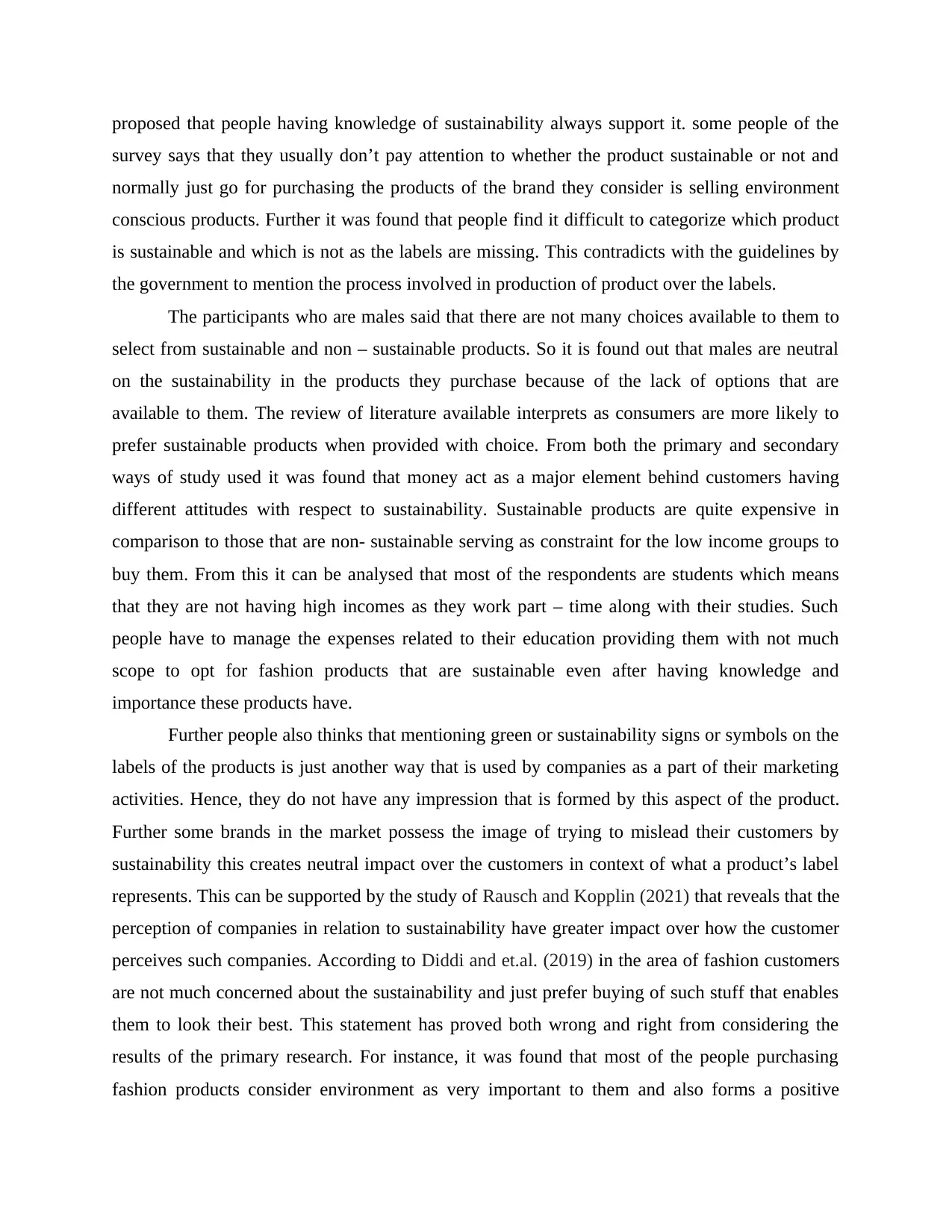
proposed that people having knowledge of sustainability always support it. some people of the
survey says that they usually don’t pay attention to whether the product sustainable or not and
normally just go for purchasing the products of the brand they consider is selling environment
conscious products. Further it was found that people find it difficult to categorize which product
is sustainable and which is not as the labels are missing. This contradicts with the guidelines by
the government to mention the process involved in production of product over the labels.
The participants who are males said that there are not many choices available to them to
select from sustainable and non – sustainable products. So it is found out that males are neutral
on the sustainability in the products they purchase because of the lack of options that are
available to them. The review of literature available interprets as consumers are more likely to
prefer sustainable products when provided with choice. From both the primary and secondary
ways of study used it was found that money act as a major element behind customers having
different attitudes with respect to sustainability. Sustainable products are quite expensive in
comparison to those that are non- sustainable serving as constraint for the low income groups to
buy them. From this it can be analysed that most of the respondents are students which means
that they are not having high incomes as they work part – time along with their studies. Such
people have to manage the expenses related to their education providing them with not much
scope to opt for fashion products that are sustainable even after having knowledge and
importance these products have.
Further people also thinks that mentioning green or sustainability signs or symbols on the
labels of the products is just another way that is used by companies as a part of their marketing
activities. Hence, they do not have any impression that is formed by this aspect of the product.
Further some brands in the market possess the image of trying to mislead their customers by
sustainability this creates neutral impact over the customers in context of what a product’s label
represents. This can be supported by the study of Rausch and Kopplin (2021) that reveals that the
perception of companies in relation to sustainability have greater impact over how the customer
perceives such companies. According to Diddi and et.al. (2019) in the area of fashion customers
are not much concerned about the sustainability and just prefer buying of such stuff that enables
them to look their best. This statement has proved both wrong and right from considering the
results of the primary research. For instance, it was found that most of the people purchasing
fashion products consider environment as very important to them and also forms a positive
survey says that they usually don’t pay attention to whether the product sustainable or not and
normally just go for purchasing the products of the brand they consider is selling environment
conscious products. Further it was found that people find it difficult to categorize which product
is sustainable and which is not as the labels are missing. This contradicts with the guidelines by
the government to mention the process involved in production of product over the labels.
The participants who are males said that there are not many choices available to them to
select from sustainable and non – sustainable products. So it is found out that males are neutral
on the sustainability in the products they purchase because of the lack of options that are
available to them. The review of literature available interprets as consumers are more likely to
prefer sustainable products when provided with choice. From both the primary and secondary
ways of study used it was found that money act as a major element behind customers having
different attitudes with respect to sustainability. Sustainable products are quite expensive in
comparison to those that are non- sustainable serving as constraint for the low income groups to
buy them. From this it can be analysed that most of the respondents are students which means
that they are not having high incomes as they work part – time along with their studies. Such
people have to manage the expenses related to their education providing them with not much
scope to opt for fashion products that are sustainable even after having knowledge and
importance these products have.
Further people also thinks that mentioning green or sustainability signs or symbols on the
labels of the products is just another way that is used by companies as a part of their marketing
activities. Hence, they do not have any impression that is formed by this aspect of the product.
Further some brands in the market possess the image of trying to mislead their customers by
sustainability this creates neutral impact over the customers in context of what a product’s label
represents. This can be supported by the study of Rausch and Kopplin (2021) that reveals that the
perception of companies in relation to sustainability have greater impact over how the customer
perceives such companies. According to Diddi and et.al. (2019) in the area of fashion customers
are not much concerned about the sustainability and just prefer buying of such stuff that enables
them to look their best. This statement has proved both wrong and right from considering the
results of the primary research. For instance, it was found that most of the people purchasing
fashion products consider environment as very important to them and also forms a positive
Paraphrase This Document
Need a fresh take? Get an instant paraphrase of this document with our AI Paraphraser
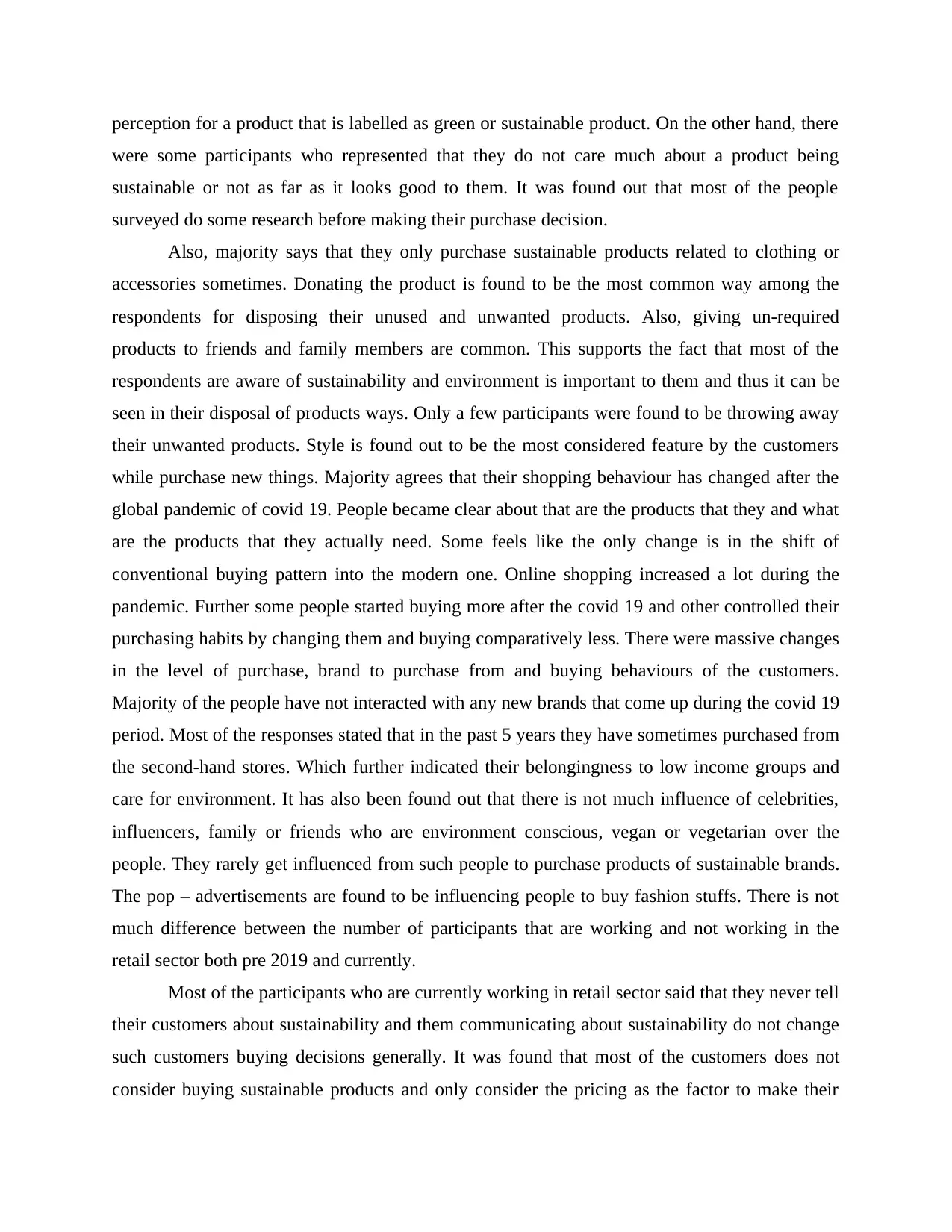
perception for a product that is labelled as green or sustainable product. On the other hand, there
were some participants who represented that they do not care much about a product being
sustainable or not as far as it looks good to them. It was found out that most of the people
surveyed do some research before making their purchase decision.
Also, majority says that they only purchase sustainable products related to clothing or
accessories sometimes. Donating the product is found to be the most common way among the
respondents for disposing their unused and unwanted products. Also, giving un-required
products to friends and family members are common. This supports the fact that most of the
respondents are aware of sustainability and environment is important to them and thus it can be
seen in their disposal of products ways. Only a few participants were found to be throwing away
their unwanted products. Style is found out to be the most considered feature by the customers
while purchase new things. Majority agrees that their shopping behaviour has changed after the
global pandemic of covid 19. People became clear about that are the products that they and what
are the products that they actually need. Some feels like the only change is in the shift of
conventional buying pattern into the modern one. Online shopping increased a lot during the
pandemic. Further some people started buying more after the covid 19 and other controlled their
purchasing habits by changing them and buying comparatively less. There were massive changes
in the level of purchase, brand to purchase from and buying behaviours of the customers.
Majority of the people have not interacted with any new brands that come up during the covid 19
period. Most of the responses stated that in the past 5 years they have sometimes purchased from
the second-hand stores. Which further indicated their belongingness to low income groups and
care for environment. It has also been found out that there is not much influence of celebrities,
influencers, family or friends who are environment conscious, vegan or vegetarian over the
people. They rarely get influenced from such people to purchase products of sustainable brands.
The pop – advertisements are found to be influencing people to buy fashion stuffs. There is not
much difference between the number of participants that are working and not working in the
retail sector both pre 2019 and currently.
Most of the participants who are currently working in retail sector said that they never tell
their customers about sustainability and them communicating about sustainability do not change
such customers buying decisions generally. It was found that most of the customers does not
consider buying sustainable products and only consider the pricing as the factor to make their
were some participants who represented that they do not care much about a product being
sustainable or not as far as it looks good to them. It was found out that most of the people
surveyed do some research before making their purchase decision.
Also, majority says that they only purchase sustainable products related to clothing or
accessories sometimes. Donating the product is found to be the most common way among the
respondents for disposing their unused and unwanted products. Also, giving un-required
products to friends and family members are common. This supports the fact that most of the
respondents are aware of sustainability and environment is important to them and thus it can be
seen in their disposal of products ways. Only a few participants were found to be throwing away
their unwanted products. Style is found out to be the most considered feature by the customers
while purchase new things. Majority agrees that their shopping behaviour has changed after the
global pandemic of covid 19. People became clear about that are the products that they and what
are the products that they actually need. Some feels like the only change is in the shift of
conventional buying pattern into the modern one. Online shopping increased a lot during the
pandemic. Further some people started buying more after the covid 19 and other controlled their
purchasing habits by changing them and buying comparatively less. There were massive changes
in the level of purchase, brand to purchase from and buying behaviours of the customers.
Majority of the people have not interacted with any new brands that come up during the covid 19
period. Most of the responses stated that in the past 5 years they have sometimes purchased from
the second-hand stores. Which further indicated their belongingness to low income groups and
care for environment. It has also been found out that there is not much influence of celebrities,
influencers, family or friends who are environment conscious, vegan or vegetarian over the
people. They rarely get influenced from such people to purchase products of sustainable brands.
The pop – advertisements are found to be influencing people to buy fashion stuffs. There is not
much difference between the number of participants that are working and not working in the
retail sector both pre 2019 and currently.
Most of the participants who are currently working in retail sector said that they never tell
their customers about sustainability and them communicating about sustainability do not change
such customers buying decisions generally. It was found that most of the customers does not
consider buying sustainable products and only consider the pricing as the factor to make their
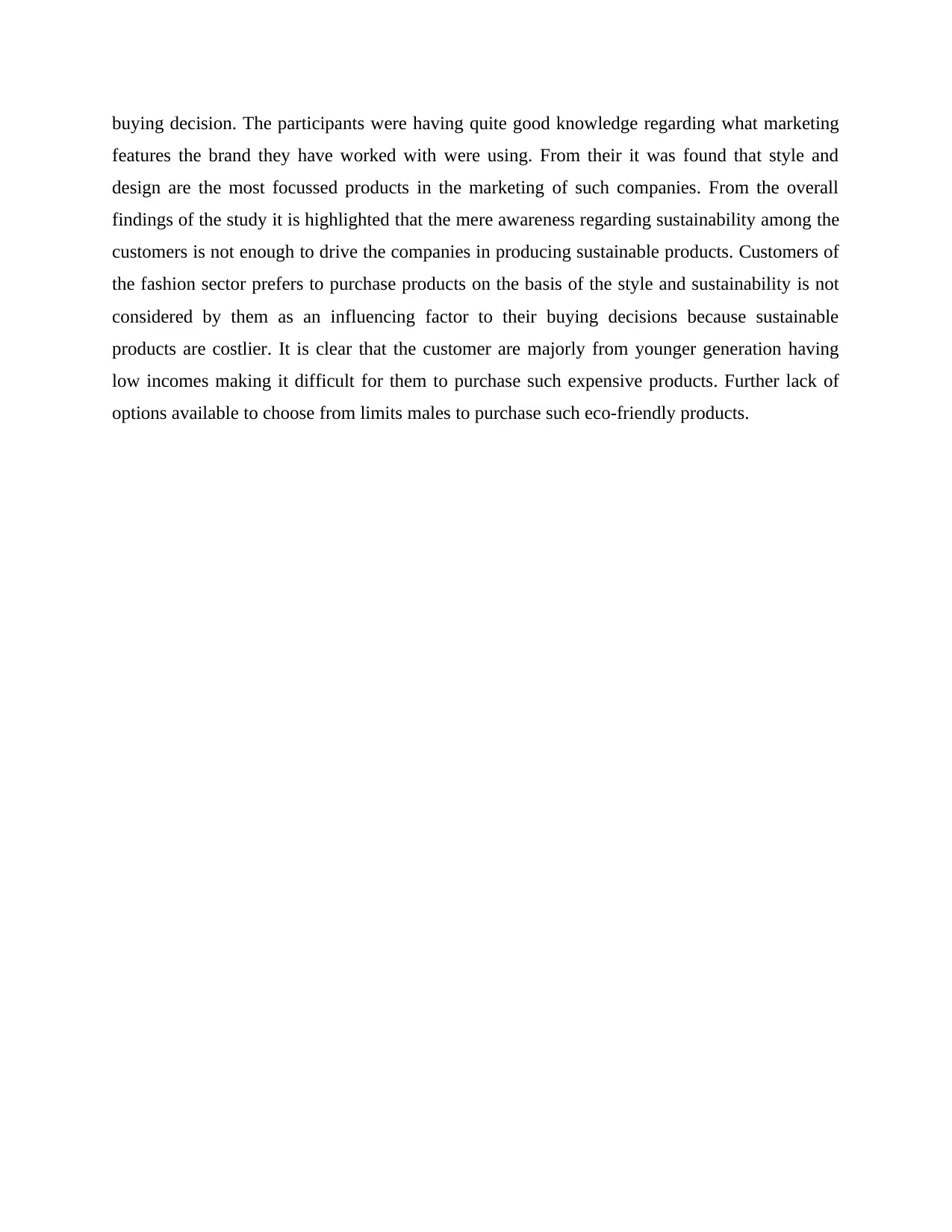
buying decision. The participants were having quite good knowledge regarding what marketing
features the brand they have worked with were using. From their it was found that style and
design are the most focussed products in the marketing of such companies. From the overall
findings of the study it is highlighted that the mere awareness regarding sustainability among the
customers is not enough to drive the companies in producing sustainable products. Customers of
the fashion sector prefers to purchase products on the basis of the style and sustainability is not
considered by them as an influencing factor to their buying decisions because sustainable
products are costlier. It is clear that the customer are majorly from younger generation having
low incomes making it difficult for them to purchase such expensive products. Further lack of
options available to choose from limits males to purchase such eco-friendly products.
features the brand they have worked with were using. From their it was found that style and
design are the most focussed products in the marketing of such companies. From the overall
findings of the study it is highlighted that the mere awareness regarding sustainability among the
customers is not enough to drive the companies in producing sustainable products. Customers of
the fashion sector prefers to purchase products on the basis of the style and sustainability is not
considered by them as an influencing factor to their buying decisions because sustainable
products are costlier. It is clear that the customer are majorly from younger generation having
low incomes making it difficult for them to purchase such expensive products. Further lack of
options available to choose from limits males to purchase such eco-friendly products.
⊘ This is a preview!⊘
Do you want full access?
Subscribe today to unlock all pages.

Trusted by 1+ million students worldwide
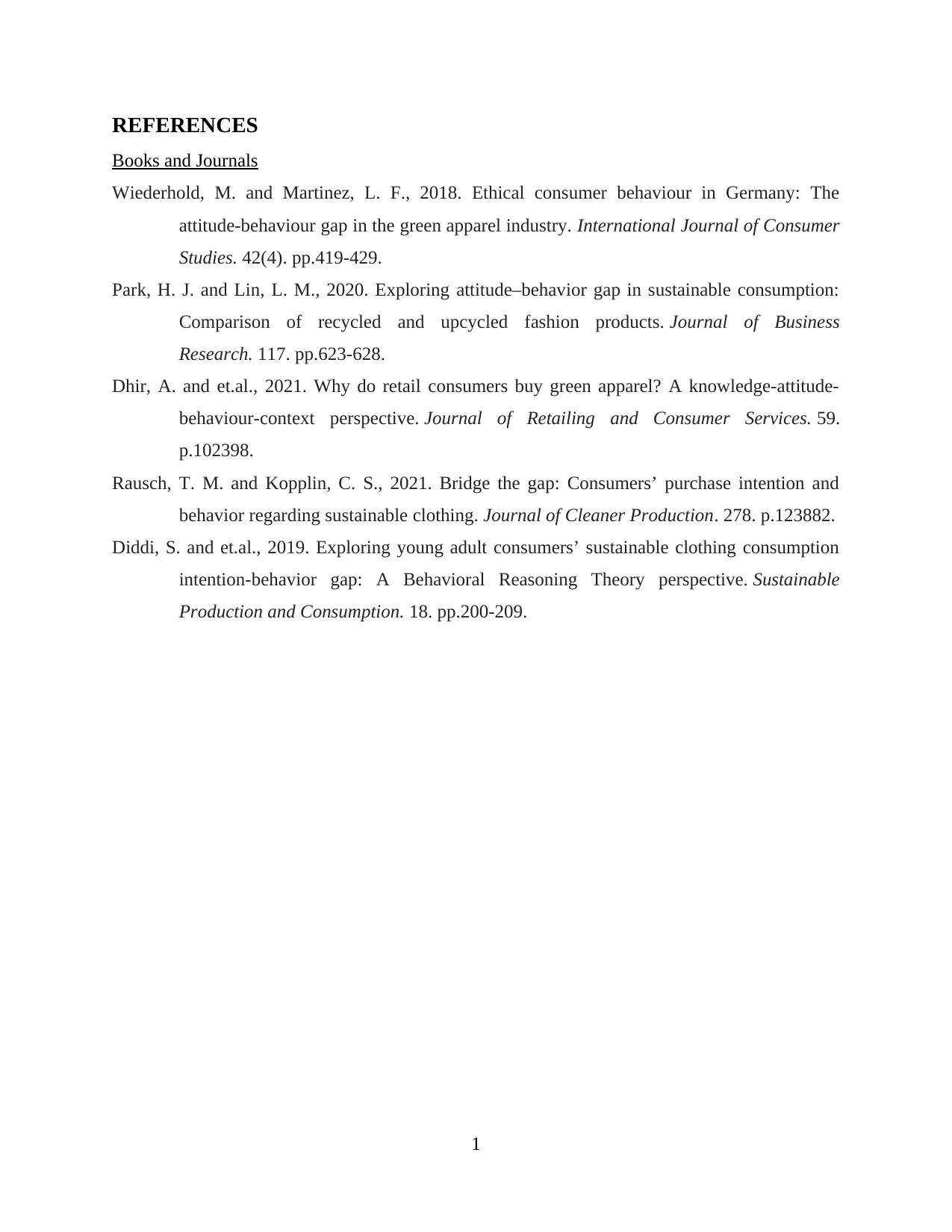
REFERENCES
Books and Journals
Wiederhold, M. and Martinez, L. F., 2018. Ethical consumer behaviour in Germany: The
attitude‐behaviour gap in the green apparel industry. International Journal of Consumer
Studies. 42(4). pp.419-429.
Park, H. J. and Lin, L. M., 2020. Exploring attitude–behavior gap in sustainable consumption:
Comparison of recycled and upcycled fashion products. Journal of Business
Research. 117. pp.623-628.
Dhir, A. and et.al., 2021. Why do retail consumers buy green apparel? A knowledge-attitude-
behaviour-context perspective. Journal of Retailing and Consumer Services. 59.
p.102398.
Rausch, T. M. and Kopplin, C. S., 2021. Bridge the gap: Consumers’ purchase intention and
behavior regarding sustainable clothing. Journal of Cleaner Production. 278. p.123882.
Diddi, S. and et.al., 2019. Exploring young adult consumers’ sustainable clothing consumption
intention-behavior gap: A Behavioral Reasoning Theory perspective. Sustainable
Production and Consumption. 18. pp.200-209.
1
Books and Journals
Wiederhold, M. and Martinez, L. F., 2018. Ethical consumer behaviour in Germany: The
attitude‐behaviour gap in the green apparel industry. International Journal of Consumer
Studies. 42(4). pp.419-429.
Park, H. J. and Lin, L. M., 2020. Exploring attitude–behavior gap in sustainable consumption:
Comparison of recycled and upcycled fashion products. Journal of Business
Research. 117. pp.623-628.
Dhir, A. and et.al., 2021. Why do retail consumers buy green apparel? A knowledge-attitude-
behaviour-context perspective. Journal of Retailing and Consumer Services. 59.
p.102398.
Rausch, T. M. and Kopplin, C. S., 2021. Bridge the gap: Consumers’ purchase intention and
behavior regarding sustainable clothing. Journal of Cleaner Production. 278. p.123882.
Diddi, S. and et.al., 2019. Exploring young adult consumers’ sustainable clothing consumption
intention-behavior gap: A Behavioral Reasoning Theory perspective. Sustainable
Production and Consumption. 18. pp.200-209.
1
1 out of 7
Related Documents
Your All-in-One AI-Powered Toolkit for Academic Success.
+13062052269
info@desklib.com
Available 24*7 on WhatsApp / Email
![[object Object]](/_next/static/media/star-bottom.7253800d.svg)
Unlock your academic potential
Copyright © 2020–2025 A2Z Services. All Rights Reserved. Developed and managed by ZUCOL.





